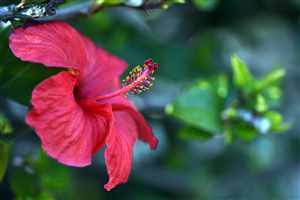Hibiscus (Hibiscus sabdariffa)
Main Facts about Hibiscus

Hibiscus is a bushy plant that grows to 8 feet with attractive large, cream-yellow flowers with red centers and red calyces. Its leaves are lobed with reddish veins and petioles. Hibiscus flowers from September to October. When the flowers fade and close, the reddish calyces begin to swell and become fleshy, ripening from the bottom of the plant to the top. Eventually the fruit matures and releases the seeds. Parts used – flowers, leaves, and seeds.
Native from India to Malaysia, Hibiscus was introduced to the southern United States in the late 19th century.
Using Hibiscus
Hibiscus is traditionally used to lower blood pressure and for its mild diuretic properties. Hibiscus tea is good for sore throats and colds.
In East Africa, the heated leaves are applied to wounds and other skin irritations. In India, a decoction of the plant’s seeds, which are considered a diuretic, is given to relieve painful urination and indigestion.
Folk traditions suggest that Hibiscus tea is good for treating anxiety, and numerous clinical trials have shown that those who consumed the tea had lower blood pressure levels than those who took a placebo or drank another type of tea.
Hibiscus can also help with constipation. The bitter roots have emollient properties and help tone the stomach and increase appetite. The plant is rich in anthocyanins (a type of flavonoid) which are considered to offer some of the health benefits.
An extract made from the flowers is used as a natural red food coloring. Hibiscus seeds have been used as a coffee substitute, chicken feed, and source of oil. Some consider the seeds an aphrodisiac.
Hibiscus is a remedy for: Cold and flu
Cooking with Hibiscus

The chopped fresh calyces can be added to fruit salads, or cooked with sugar to make a sauce. For finer-textured syrup, run the cooked sauce through a sieve. The syrup can be added to puddings or salad dressings, or used as a topping for desserts.
Hibiscus young leaves taste like spicy spinach. They are good in salads, or cooked with vegetables, rice, or fish.
Hibiscus tea: Pour 1 cup boiling water over 1-2 tsp dried flowers. Steep for 10 min. Strain and sweeten, if desired. Drink 2 cups per day.
How to grow Hibiscus
Frost-sensitive Hibiscus thrives in full sun and moist, fertile soil. Hibiscus flowers best in temperatures between 60-90F (16-32C) and cannot tolerate temperatures below 32F (0C). It can be started outdoors from seed in Zones 8 through 11. In cooler regions, start the seed indoors and move the plant outdoors after all danger of frost has passed and temperatures have warmed. The plants take up to 8 months to fruit.
When Hibiscus is blooming, it requires large amounts of water. Water daily in warm weather. Once the weather cools, Hibiscus needs far less water, and too much water can kill it. In the winter, water only when the soil is dry to the touch.
| Hawthorn |
Hops
|